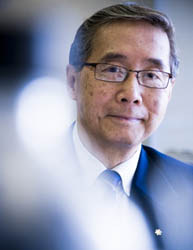Blood-cell pioneer marks 50th anniversary
Blood-cell pioneer marks 50th anniversary McGill University
User Tools (skip):
Blood-cell pioneer marks 50th anniversary

CHANG: Proving the scoffers wrong.
Half a century ago, McGill physiology undergraduate Thomas Chang had a brainstorm. The physiology, size and chemistry of the red blood cell were well understood, so why not make artificial cells? Yet, when he enthusiastically approached some colleagues in the Chemistry Department for help, their response was—to be diplomatic—less than enthusiastic.
"They gave me a funny look. They thought I was stupid," he laughs. "After that I kept quiet about it and did the experiment in my residence room." Looking back, he marvels at the patience of his roommates as he experimented with some scrounged hæmoglobin, a few perfume atomizers and liquid colloidal plastic, which turned into a flexible film as it hardened. In the end, his roommates' understanding and his effort paid off: He proved it was possible to seal hæmoglobin inside microscopic, flexible plastic membranes, creating the world's first artificial blood cells.
Dr. Thomas Ming Swi Chang, BSc'57, MD'61, PhD'65, has come a long way since those first jury-rigged experiments in Douglas Hall. He is now, at the age of 74, in his fifth decade at McGill, first as a student and later as a professor of physiology, medicine, biomedical engineering and chemistry. He is the long-time Director of McGill's Artificial Cells and Organs Research Centre and was inducted into the Order of Canada in 1991. As for where those scoffers of long-ago ended up; who knows?
In hindsight, it's obvious that the creation of the artificial cell was one of the first shots in the bio-engineering revolution. In the late 1950s, though, despite being published as sole author in Science (an almost unheard-of accomplishment for a), the importance of his discovery was less than clear. In a world where the polio vaccine was a brand-new innovation and organ transplants were still science fiction, the artificial blood cell was an interesting curiosity with no obvious practical application. Moreover, Chang was a pre-med student with over a decade of medical school and internship still ahead of him.
In the late 1960s, he made a breakthrough: the discovery of enzymes which, when carried in artificial cells, might be capable of correcting inborn metabolic errors. However, in 1970, he set that theoretical research aside to work on an invention with more immediate life-saving potential: Hæmoperfusion, a technique which uses artificial cells filled with activated charcoal to treat drug poisoning. Hæmoperfusion became the global standard for use in poisoning cases, and led to spin-offs like the artificial kidney, an important, low-cost alternative to the then-rare and prohibitively expensive dialysis machine.
The outbreak of AIDS and the rash of tainted-blood scandals that followed in the 1980s focused worldwide attention on the need for safe blood substitutes and on Chang's accomplishments. In 1991, he was made an Officer of the Order of Canada. More recently, he gave the plenary lecture at the 11th International Symposium on Blood Substitutes in Beijing, where he was made honourary president by China's vice-minister of health, and was surprised at the end of the conference with a special achievement award to honour his achievements.
"Even more surprisingly, they gave me a plaque confirming me as an honourary professor at the Peking Union Medical College," he adds. Not bad for someone who started out with perfume atomizers in his dorm room.

